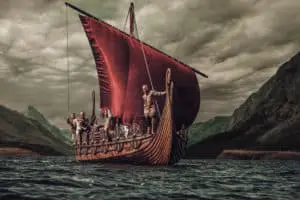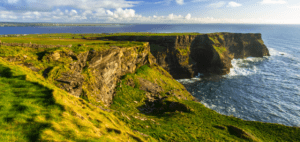A Guide to Ireland’s Diverse County Dance Traditions
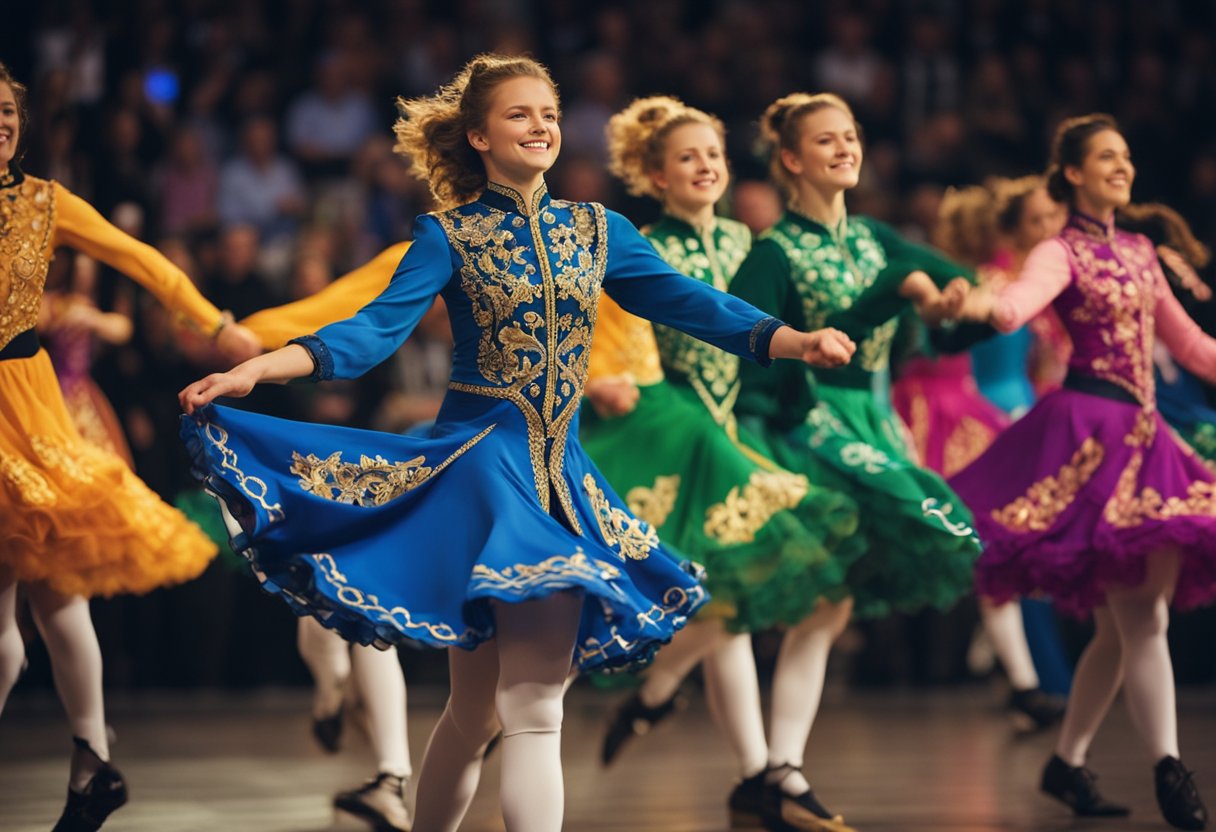
Updated On: April 16, 2024 by Maha Yassin
Embarking on a journey through Ireland’s dance traditions reveals much more than just the steps of a dance; it uncovers a rich tapestry of culture woven through the fabric of our national identity. Each country in Ireland offers unique interpretations and styles of Irish dance, which are deeply interwoven with our local customs and history. Through these regional variations, from the lively jigs of County Kerry to the precise steps found in County Donegal, we discover Irish culture’s remarkable diversity and ingenuity.
The dance performances in Ireland are not merely for amusement—every leap and turn carries the weight of centuries of tradition, resonating with the heartbeat of Irish music. Our music sets the pulse for Irish dance, and together, they act as vibrant expressions of Ireland’s cultural narrative. As we explore beyond Riverdance, we unearth many dance forms, such as the social gatherings of ceilis and the spirited competition dances, strengthening our collective identity.
The History and Roots of Irish Dance Traditions
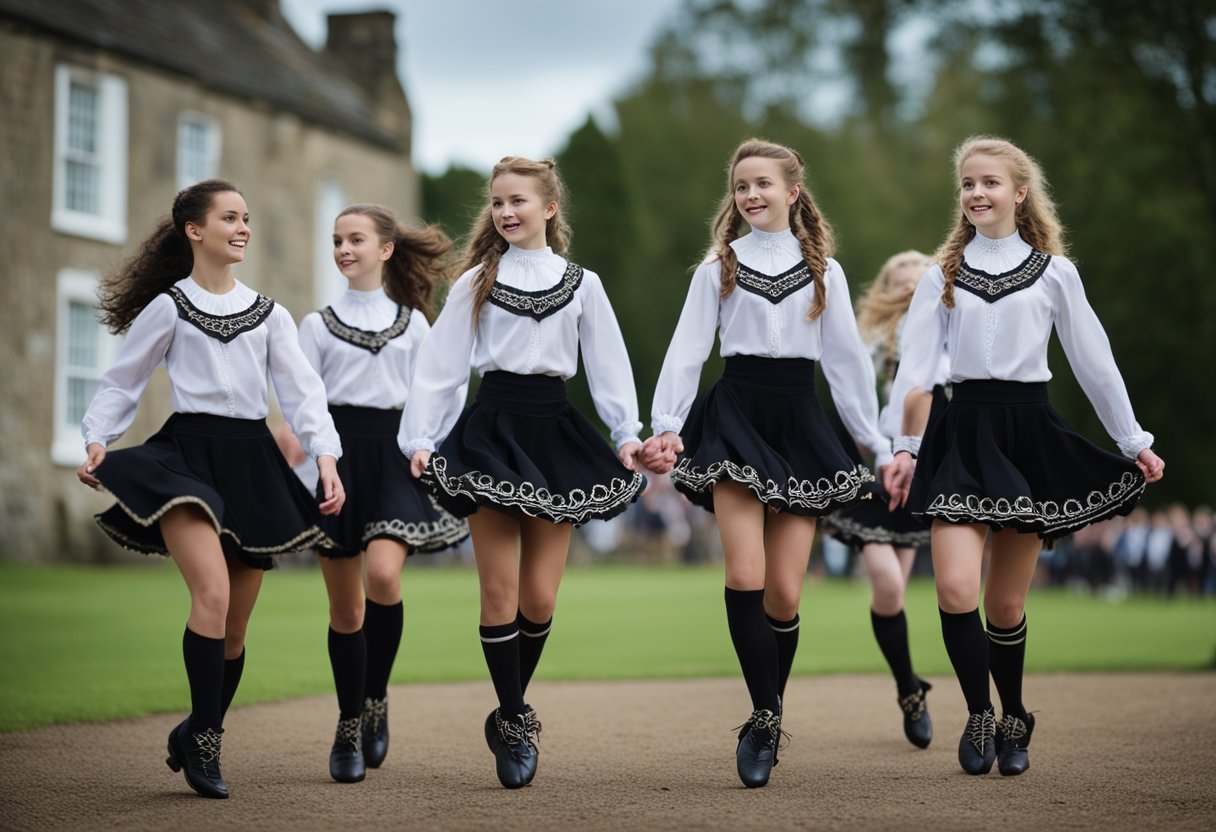
We explore the deep-seated traditions of Irish dance, delving into its ancient beginnings and global rise through shows such as Riverdance and the pivotal roles of icons like Michael Flatley and Jean Butler.
Early Origins and Evolution
Irish dance has a rich history that intertwines with the Celtic culture, flourishing since the times of the ancient Celts who arrived in Ireland around 500 BC. This art form was integral to their societal and religious practices. It has experienced a revival and transformation over the centuries. The 16th century saw the emergence of dance forms like the Irish jig, while by the 18th century, itinerant dancing masters were travelling across the country, teaching new steps and contributing significantly to the evolution and spread of traditional styles, including sean-nós dancing.
The Global Phenomenon of Riverdance
The 1994 Eurovision Song Contest interlude act, featuring the enthralling performance of Riverdance, marked a milestone in Irish dance, bringing it to a worldwide audience and sparking a renewed interest in this cultural expression. Riverdance’s fusion of traditional Irish steps with modern theatre transformed Irish dance into an international sensation, leading to sell-out shows globally. Its historical significance cannot be overstated, as it played a key role in the revival of the Irish dance tradition and its global reach.
Contributions of Michael Flatley and Jean Butler
Michael Flatley and Jean Butler are names synonymous with the renaissance of Irish dance. Their dynamic performances in Riverdance and innovative choreography set the stage for a new era of this dance form. Flatley, with his flamboyant style, went on to create shows like “Lord of the Dance,” further popularising Irish dance and the Celtic influence. Jean Butler’s elegance and technical prowess also highlighted the artistic potential of Irish dance, inspiring legions of dancers worldwide.
Regional Dance Styles Across Ireland
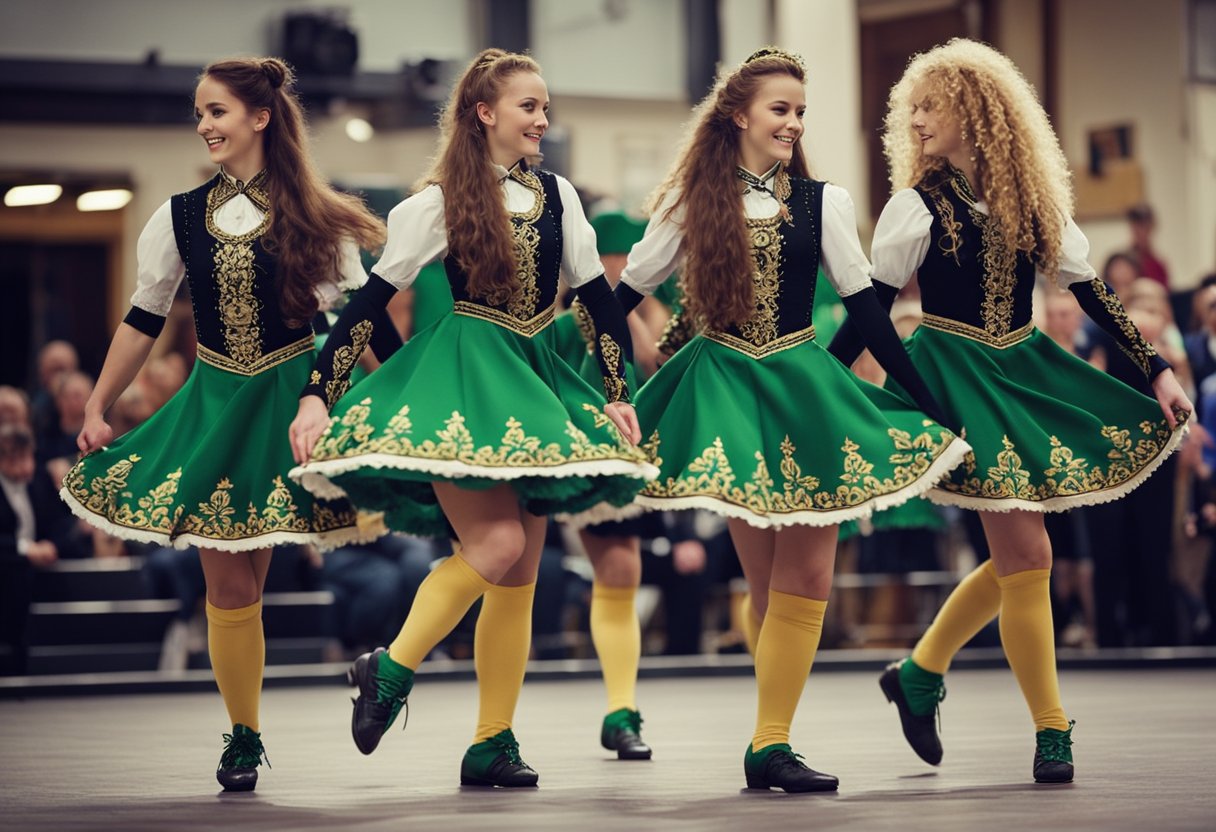
Ireland boasts a rich tapestry of dance traditions, nurturing each country’s distinctive style. We delight in exploring the regional nuances contributing to Ireland’s dance heritage.
Dublin’s Rhythmic Variations
The traditional step dance in Dublin pulsates with variety, reflecting the city’s cosmopolitan nature. With influences from rural Ireland and international visitors, dancers in Dublin often showcase a synthesis of styles, mixing the meticulous precision of classic steps with a flair for improvisation.
Limerick’s Dynamic Footwork
Limerick is home to energetic dance traditions where dancers exhibit dynamic footwork. The emphasis in Limerick’s step dance is on the speed and complexity of movements, challenging dancers to maintain gracefulness amid rapid steps and vibrant rhythms.
Connemara’s Sean-Nós Dance
Connemara’s Sean-Nós dance is a freeform and expressionistic style that starkly contrasts the rigidity typically found in other step dances. This more relaxed and personal style is deeply rooted in Connemara’s Gaeltacht (Irish-speaking regions), where individual expression is treasured.
Cork’s Complex Set Dances
Cork proudly sustains complex set dances, often performed in groups with a sequence of figures akin to quadrilles. These sets are not just dances but communal experiences that reinforce county bonds and are integral to Cork’s cultural gatherings.
County Clare’s Traditions
County Clare has long been a bastion of Irish traditional music and dance. The local dance tradition frequently features a lower centre of gravity and a focus on the subtle nuances of musical accompaniment, allowing dancers to demonstrate both finesse and footwork intricacy.
County Kerry’s Unique Steps
Finally, Kerry is celebrated for its unique steps that stray from the standard patterns found elsewhere. Dancers in Kerry are known for their swift and nimble footwork, with rapid yet controlled movements, often telling a story through dance.
The Music That Moves Irish Dance

We recognise that the essence of Irish dance is often found in its accompanying music. The pulsating rhythms and melodic flourishes bring the dancers to life, each county in Ireland contributing its unique sound to the tradition.
Instruments Central to the Dance
The fiddle is quintessential, known for its versatility and ability to convey the wide emotional range of Irish music, from spirited jigs to heartfelt airs. The Uilleann pipes, with their complex and haunting tones, add a distinctive voice synonymous with traditional Irish music. The Celtic harp, with its resonant strings, historically provided the melody for the dance. At the same time, the bodhrán, a type of drum, is the heartbeat, offering the foundational rhythms that guide the dancers’ feet.
Influential Composers and Musicians
The works of countless composers and musicians have shaped Irish dance music. Tunes penned by legendary figures like Turlough O’Carolan have transcended centuries, while contemporary artists continue introducing innovative compositions. These musicians are often versed in various modes, like Dorian and Mixolydian, which lend Irish music its distinctive sound.
Traditional Irish Music and its Evolution
Traditional Irish music is a tapestry of melodies and traditional tunes handed down through generations. Rooted in Celtic traditions, this music has evolved yet retains the essence that initially defined it. Today, we witness a fusion of traditional elements with modern influences, an evolution that continually breathes new life into the melodies that move the world of Irish dance.
The Cultural Significance of Dance in Ireland
In traversing from county to county in Ireland, one witnesses a vibrant cultural tapestry, with dance intricately woven into its very fabric. This rich legacy serves as a means of artistic expression and a profound indicator of Irish identity, heritage, and social cohesion.
Dance as a Reflection of Irish Identity
Irish dance is a dynamic mirror reflecting our cultural identity. Each country boasts unique styles and traditions, contributing to our sense of belonging. Whether it’s the precise footwork of the step dance or the more relaxed form of sean-nós, these forms embody the Irish spirit and our shared experience.
Cultural Heritage and Preservation in Dance
We acknowledge the central role of dance in maintaining our cultural heritage. Through traditional dance, we preserve our collective narrative. Initiatives such as the cultural envoy of Irish dance have transcended borders, ensuring that these practices endure from one generation to the next.
The Emotional and Social Impact of Dance
Irish dance is a unifying force, with its emotional resonance rippling through social gatherings. The ceilidh dances foster a profound sense of community, offering a shared experience where all involved partake in the joy and exuberance of Irish culture. At these social dances, lasting bonds are formed, reinforcing our cultural tapestry through each step and tune.
Traditional Irish Dance Attire and Instruments
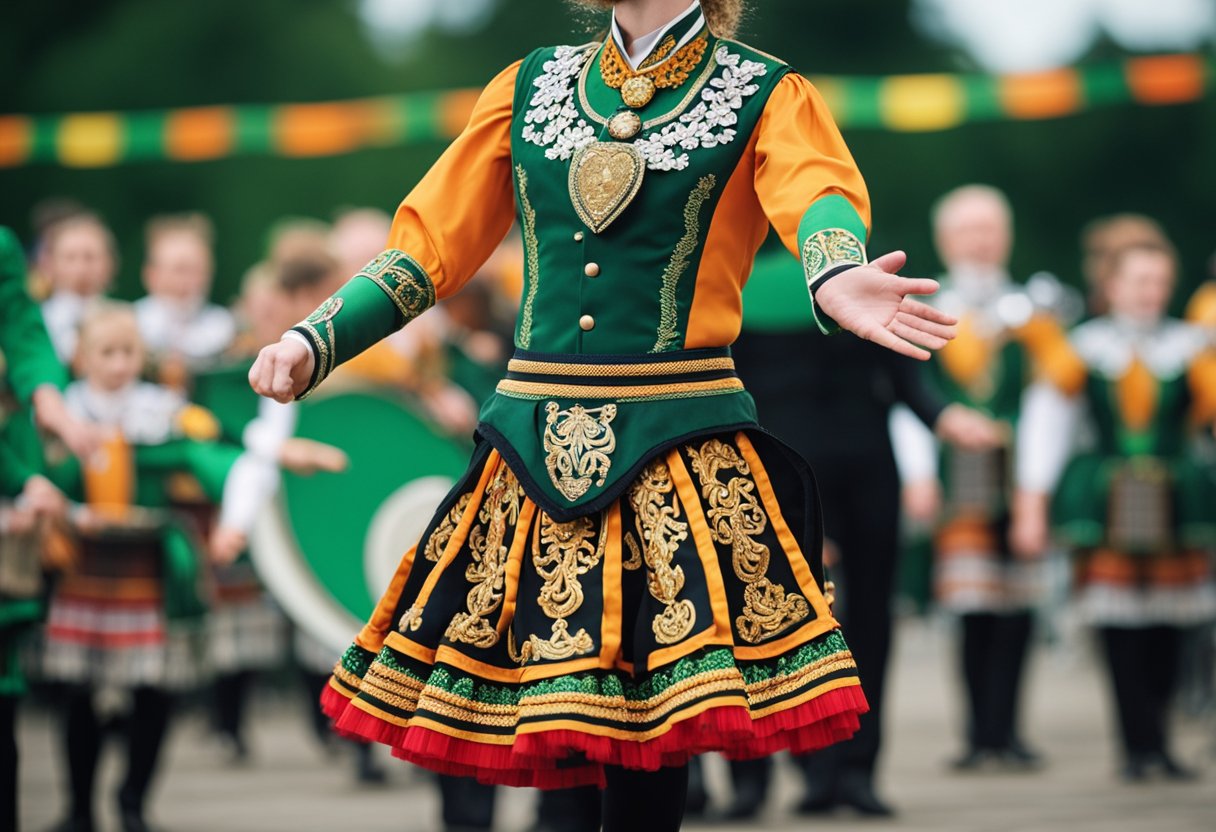
In exploring the rich tapestry of Irish dance traditions, we find that attire and musical instruments are as central to the performance as the dance moves. Each county in Ireland may offer its variations, but some elements remain deeply rooted in tradition.
The Evolution of Dance Costumes
Irish dance costumes have undergone significant changes over time. Initially, dancers would perform in their everyday clothes. As the traditions formalised, women adopted the an cóta mór (a full-length dress), and men donned the knee breeches. Today’s costumes reflect a blend of modernity and tradition, with hand-embroidered details that pay homage to Celtic designs.
Footwear: From Ghillies to Hard Shoes
The choice of footwear is dependent on the dance style. Ghillies or soft shoes are worn for soft shoe dances; these are light, flexible, and work well for the quick and precise footwork required. Like tap shoes, hard shoes produce a distinctive rhythm and percussion and are worn for dances such as the jig and hornpipe.
The Role of Instruments in Performance
The essence of a traditional Irish dance performance is incomplete without its musical accompaniment. Instruments like the fiddle, flute, and bodhrán are integral, providing the tempo and rhythm to which dancers, solo or in Céilí groups, synchronise their movements. These instruments have helped carry the heartbeat of Irish dance through generations.
Popular Dance Forms: Jigs, Reels, and Ceilis
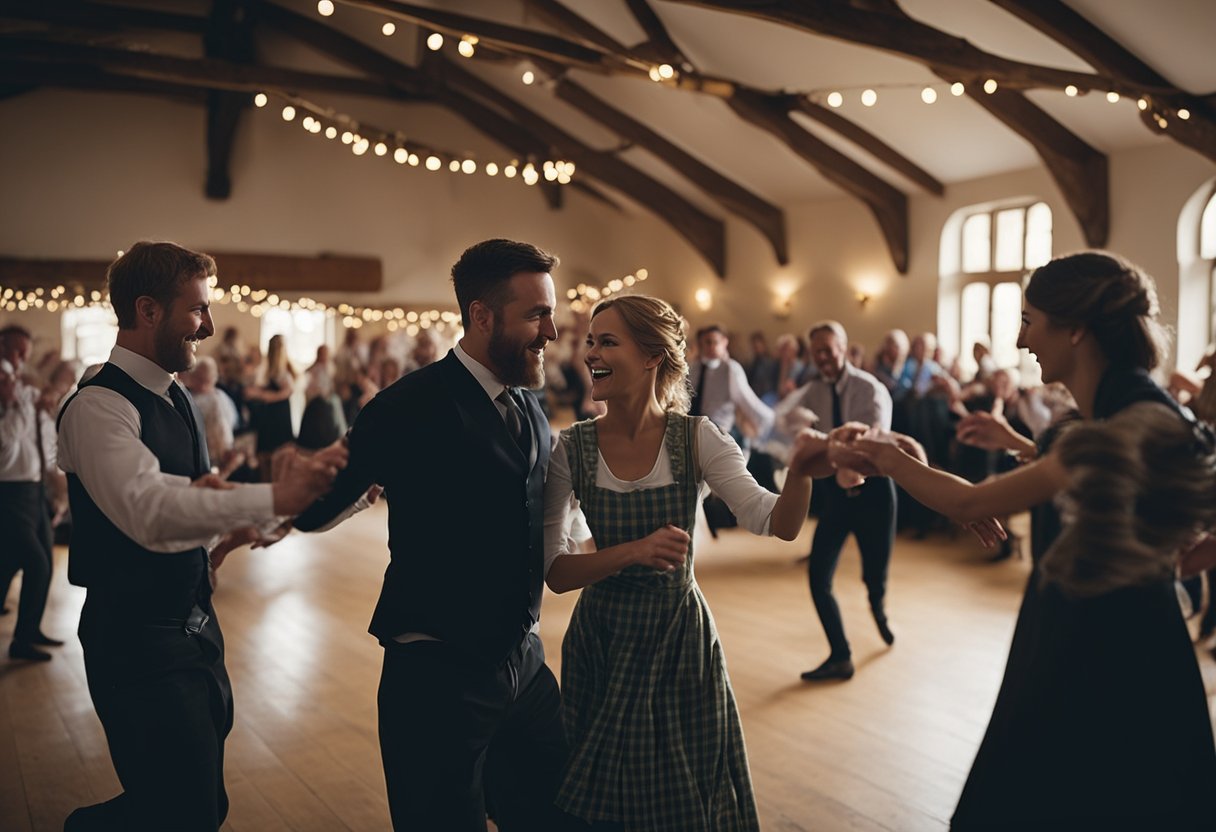
In Ireland, traditional dance forms such as jigs, reels, and céilí dancing are cornerstones of cultural expression, each with distinctive qualities and social contexts. These dance styles are celebrated for their rich historical roots and continue to be a vibrant part of Irish heritage.
The Structure and Rhythm of Jigs
We recognise jigs as lively dance forms with a compound time signature, typically 6/8. The most common type, the standard double jig, emphasises a bouncing rhythm mirrored in the dancers’ light-hearted steps. Another variation, the slip jig, is recognised for its unique 9/8 time signature, imparting a more fluid, graceful movement.
The Energetic Pace of Reels
In contrast, reels are fast-paced dances flowing with the spirited beat of a 4/4 time signature. The reel is a cornerstone of traditional Irish music sessions and dance festivals, characterised by a driving rhythm that encourages an energetic response from both musicians and dancers.
Community and Celebration in Céilí Dancing
Céilí dances are a community affair, fostering social connection through structured patterns in group dances. These traditional dances utilise jig and reel rhythms, often involving line or circle formations, ranging from simple to complex steps. The focus on rhythmic patterns makes céilí dancing both a celebration of Irish culture and a sociable pastime that brings the community together.
These popular dance forms are intrinsic to the fabric of Irish tradition, with each country offering its unique interpretations and styles. Our shared efforts to preserve and participate in these dances ensure that the pulse of Irish culture continues to beat strong within our communities.
Dancing Competitions and Festivals
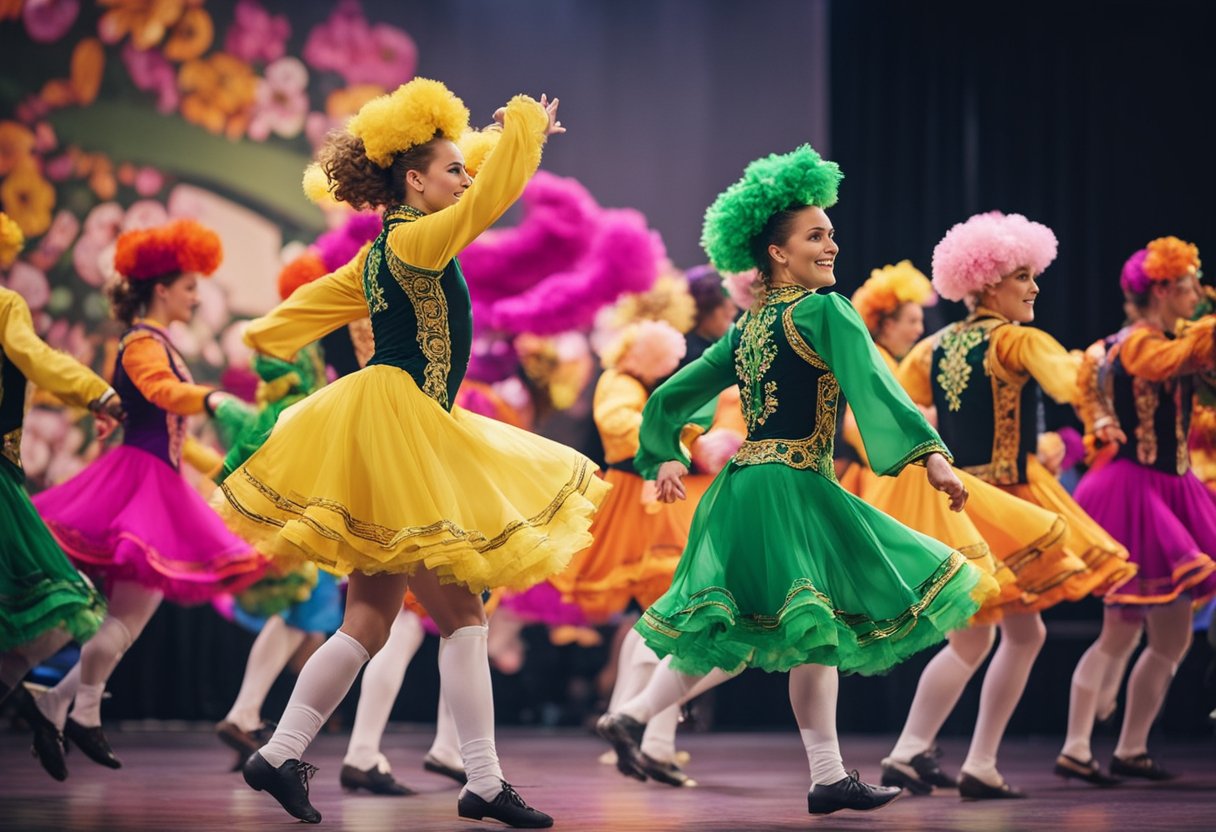
Exploring the dance traditions of Ireland through its competitions and festivals allows us to understand the enduring legacy and evolving nature of Irish dancing. These events are pivotal in defining, celebrating, and educating communities and enthusiasts about the intricacies of Irish dance culture across countries.
Local and National Competitions
Local and national competitions are the heartbeat of Irish dance, showcasing the skill and dedication of dancers. Feiseanna, or festivals of competition, occur throughout the calendar year in various counties, offering dancers the opportunity to qualify for national and international contests. The Irish Dancing Commission (An Coimisiún le Rincí Gaelacha) oversees these competitions, ensuring adherence to tradition and excellence in performance. From beginners to seasoned professionals, dancers vie for titles, perpetuating a culture of excellence and community pride.
Festivals Celebrating Irish Dance Culture
Festivals bring the vibrancy of Irish dance to the fore, celebrating both the traditional and modern iterations of this folk art. These events often coincide with significant cultural dates, include performances live music, and sometimes tie into larger competitions. Riverdance, for instance, transcended its initial performance at the Eurovision Song Contest to become a global phenomenon, inspiring the creation of numerous festivals and shows that honour the spirit of Irish dance culture. These events are essential in bringing together the wider Irish dance community and fostering a shared sense of heritage.
Educational Programs and Workshops
Educational programmes and workshops play a crucial role in perpetuating Irish dance. They bridge the gap between generations and provide a platform for continuous learning. These educational programs often run with festivals, offering intensive training and knowledge exchange between novice participants and master dancers. Workshops cover a range of subjects, from dance techniques to music interpretation, ensuring that the tradition remains dynamic and relevant. They serve not only as a guide for aspiring dancers but also as a way to reinforce community bonds through shared learning experiences.
The Technique and Choreography of Irish Dance
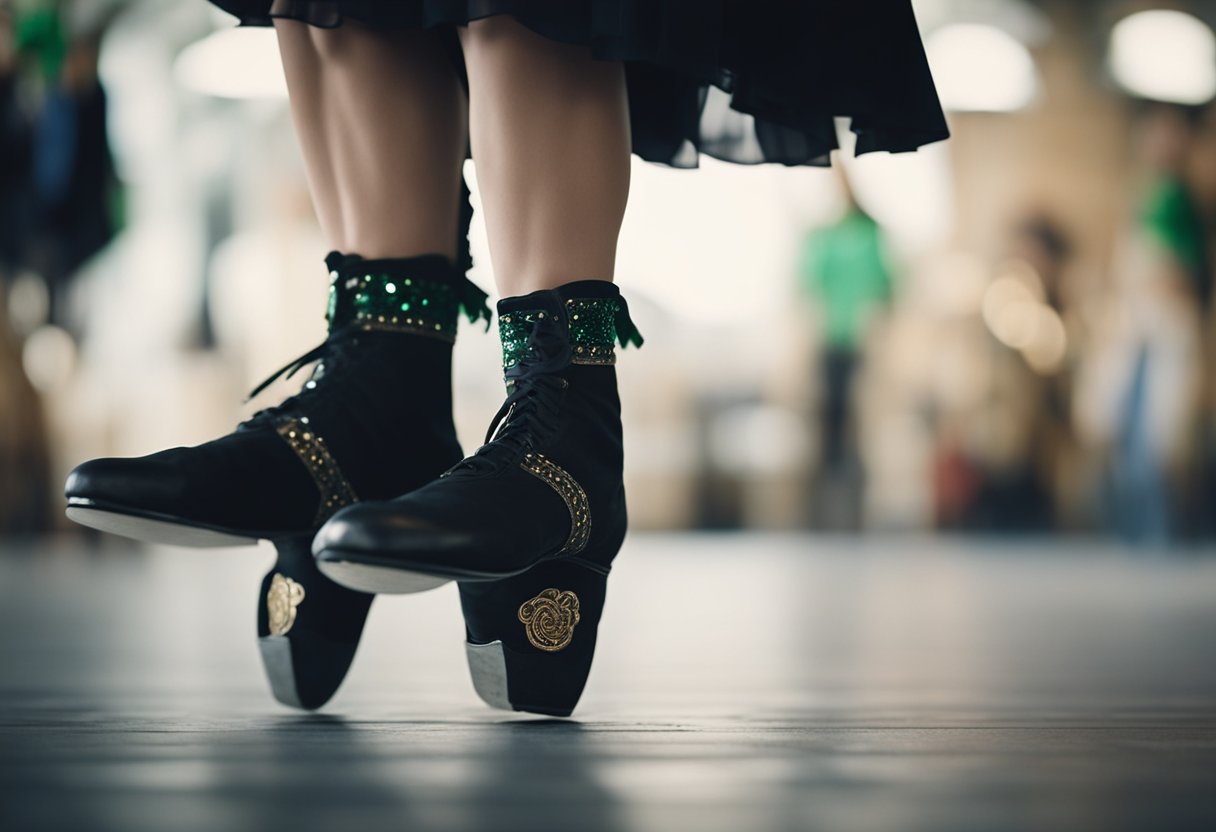
In Irish dance, technique and choreography are pivotal elements that contribute to the vibrancy and dynamism of this cultural expression.
Step Dance: A Blend of Precision and Artistry
Step dance in Ireland is a technical dance form that demands a high level of precision and skill. Our footwork is intricate, with rapid movements performed close to the floor. The structured patterns of the dance are central to the tradition, often characterised by a stiff upper body and quick, precise movements of the feet. Step dance showcases a combination of solo and group dancing, with individual performers often executing rhythmically complex sequences while group routines emphasise uniformity and synchronisation.
When we consider the choreography of step dance, it’s essential to focus on the balance between maintaining the legacy of the art form and incorporating new, innovative movements. The rich tradition evolves with each generation, maintaining its core while exploring fresh interpretations and executions of the dance.
Innovations in Irish Dance Choreography
Innovation in Irish dance choreography transforms and revitalises the art form, ensuring its continued relevance in contemporary performance. Choreographers like Jean Butler have been at the forefront of this evolution, bringing a new vision to the stage that honours tradition while pushing the boundaries of the genre.
We inject creativity and modernity into our dance routines by experimenting with contemporary music and diverse dance styles without losing the essence of traditional Irish dance. This approach challenges dancers to adapt and expand their technical abilities and offers audiences a rich, evolving cultural experience. Through these innovations, we continue to enchant and engage spectators, providing an energetic showcase of Irish culture and heritage that resonates far beyond the shores of Ireland.
Modern Interpretations and Fusion Styles
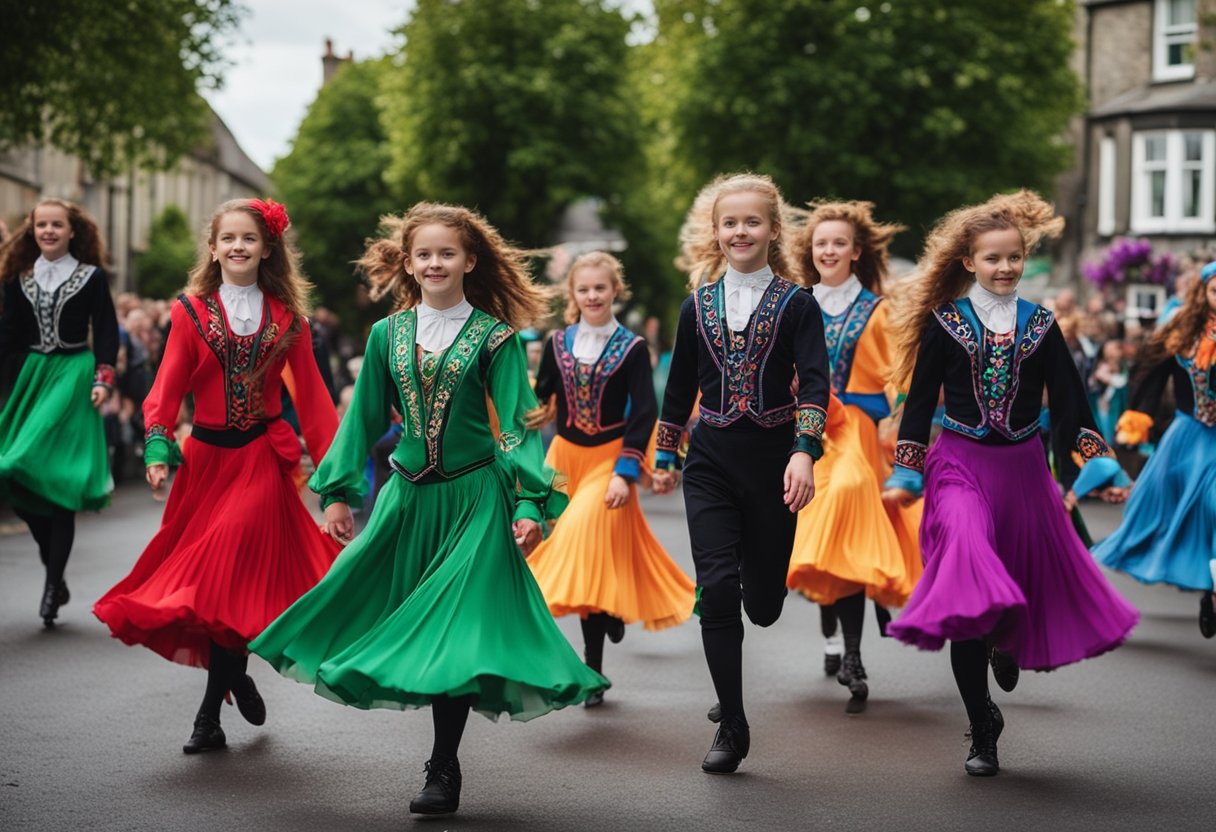
We’re witnessing a vibrant era where innovation and tradition merge within Irish dance, leading to modern interpretations and fusion styles that honour and expand upon Ireland’s rich dance heritage.
Celtic Tiger: Ireland’s Dance Revolution
The phrase ‘Celtic Tiger‘ refers not only to the economic boom Ireland experienced but also to a period of revolution in our nation’s dance scene. During this time, Riverdance emerged as a global phenomenon, radically transforming the public perception of Irish dance. This theatrical show combined traditional Irish steps with high-energy, modern choreography and international influences, showcasing a fusion style of dance that resonated worldwide. With the acclaim and success of Riverdance, Irish dancers have felt emboldened to innovate and experiment, leading to a new wave of hybrid dance styles that maintain the essence of Irish dance tradition while incorporating contemporary elements.
Contemporary Influences on Traditional Forms
The impact of modern culture on traditional Irish dance forms cannot be understated. As dancers engage with various influences, we find a burgeoning scene where traditional steps meet the creativity of modern dance. Through this interaction, innovation in music, costume, and choreography brings new life into our dance tradition.
Irish dance companies and choreographers are now creating fusion styles that are sophisticated and experimental, incorporating elements from ballet, jazz, and even hip-hop. These contemporary interpretations showcase a dynamic evolution, yet our national identity and cultural expressions remain firmly rooted at the core. Each county in Ireland harbours its unique flair and contributes to the overall tapestry of our modern dance culture, making exploring Ireland’s dance traditions a remarkably diverse experience.
Irish Dance as an Educational Tool
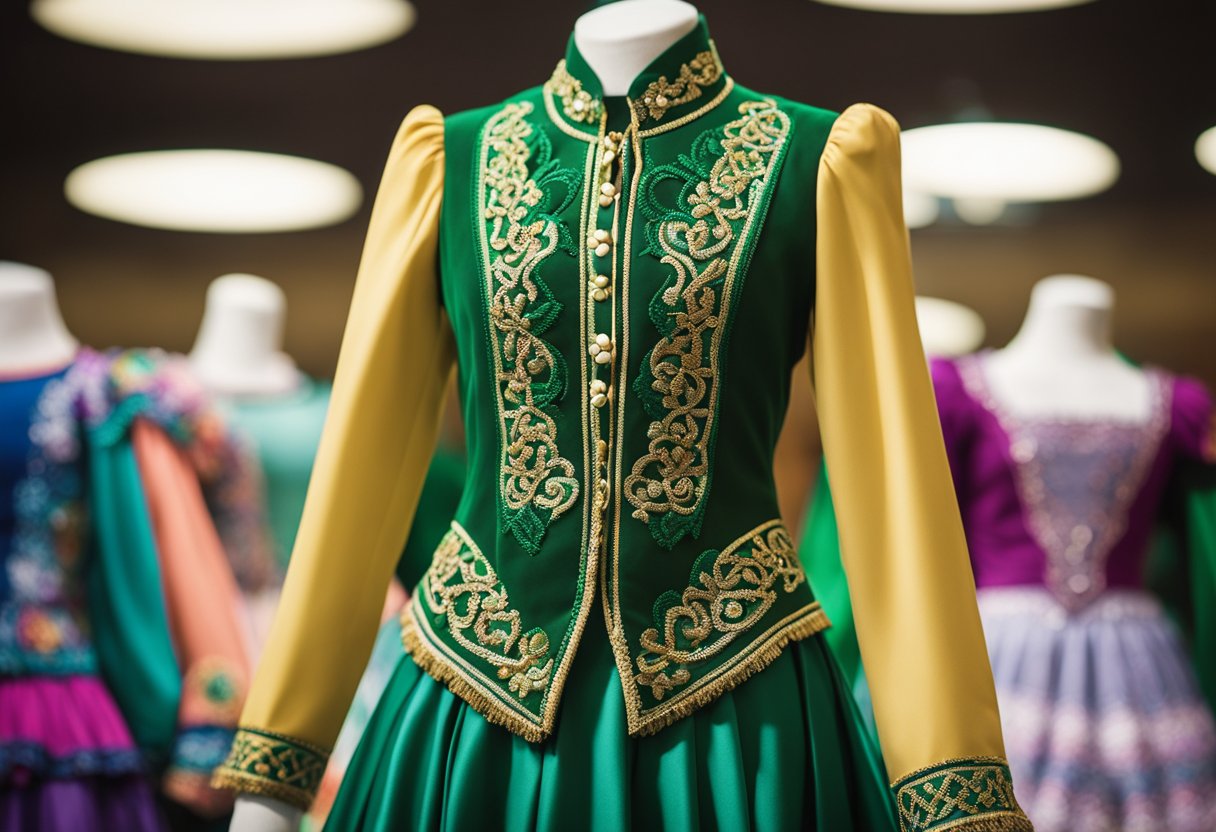
Irish dance isn’t just a cultural spectacle but a vital educational tool that plays a transformative role in communities, promoting Irish heritage and fostering resilience. Through educational programmes, dance schools, and local Irish centres, the traditions of Irish dance have become an invaluable part of social education.
Dance Schools and Their Role in the Community
Dance schools provide more than just dance instruction; they create a sense of community and cultural continuity. These schools often function as hubs where individuals of all ages can connect with their heritage. Through social dance classes and educational programmes, dance schools contribute to preserving Ireland’s cultural heritage. They create environments where stories and traditions are passed down through generations, ensuring the resilience of the Irish dance tradition.
Programmes Promoting Irish Dance and Culture
Various programmes actively work to promote Irish dance and culture within and beyond local communities. For instance, initiatives like those conducted by the Irish Centre often provide a comprehensive slate of activities that are educational in focus and rich in cultural context. These may range from introductory courses in traditional Irish dance forms for school children to more advanced workshops for adults focused on the performance aspects of dance. These structured programmes are vital in maintaining a living tradition as an art form and a historical record.
The Resilience of Dance Through Education
The teaching and learning of Irish dance foster cultural awareness and imbue participants with a sense of resilience and dedication. The fluidity and adaptation of Irish dance are celebrated by integrating dance education into the daily fabric of community life and ensuring its presence in festivities and local events. This educational resilience is pivotal, allowing Irish dance to flourish even as the world changes, making it a timeless and dynamic art that continues to enthral and inspire.
Frequently Asked Questions
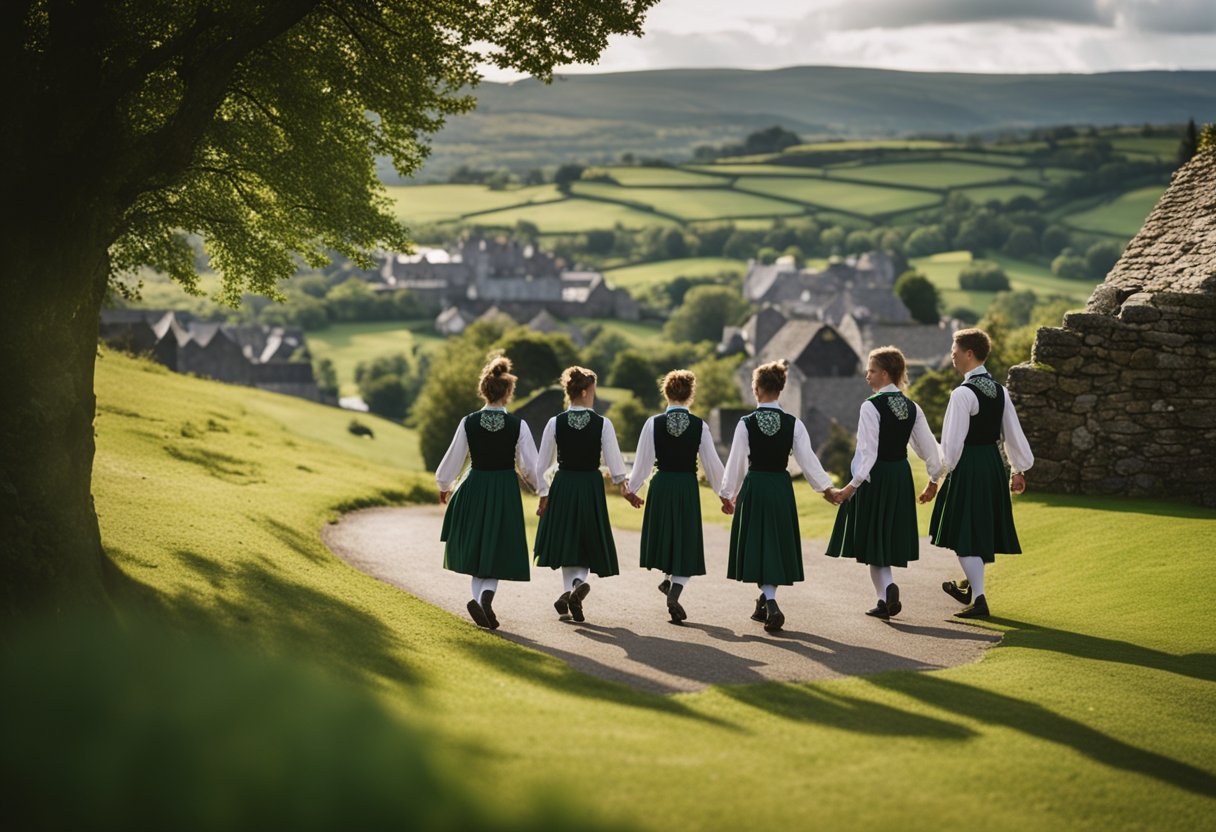
In traversing the rich tapestry of Irish dance, one encounters a vibrant variety of forms that are as diverse as the Irish landscape. Our journey through the dance traditions of Ireland reveals unique regional styles, each telling a story of the local culture and history.
What are the distinct styles of Irish dance across various countries?
Each country in Ireland contributes its flair to the realm of dance. Step dancing in counties like Cork and Kerry features low-to-the-ground movements, while the athletic leaps of Connemara are noteworthy. The intricate footwork of the Ulster style distinguishes it from the more relaxed Munster style of dance.
How has traditional Irish music influenced regional dance forms?
Traditional Irish music, with regional variations in style and instrumentation, greatly shapes the associated dance forms. For instance, the rapid reels of Donegal propel energetic dance sequences, whereas the languid pace of Clare’s jigs influences a smoother style of dancing that flows with the music’s rhythm.
In what ways do Irish dance traditions vary from the North to the South of Ireland?
Northern Irish dance traditions often display a strong Scottish influence, noticeable in the precise and sharp movements. Moving south, a gradual shift towards a more relaxed and free-flowing style, emphasising the music’s beat and a less rigid upper body.
Can you outline the history and evolution of Irish dance?
Irish dance’s lineage stretches back centuries, with references from the 17th century. After flourishing in the 18th and 19th centuries hedge schools, it saw a revival in the 20th century, culminating in global phenomena like Riverdance, which introduced Irish dance to a worldwide audience.
What are some lesser-known Irish folk dances and their origins?
Beyond the widespread jigs and reels, there’s a wealth of lesser-known dances such as the sean-nós, an improvised dance known for its close-to-the-floor style, primarily from Connemara. Set dances, performed in groups with fixed steps, vary from county to county, with distinct sets like the Clare Lancers and the Galway Reel.
Could you detail the role of dance in Irish cultural and social events?
Dance is central to social gatherings and cultural festivities in Ireland, serving as a communal activity that strengthens community ties. From weddings to céilís, dance fosters social cohesion and provides a platform for storytelling and celebrating Irish heritage and identity.


